Social Media and Older Adults (1995–2023): A Bibliometric Analysis with Implications for Media Education in Lifelong Learning
Abstract
1. Introduction
- -
- Objective 1 (O1): Analyze scientific production on social networks and the elderly sector, identifying the main areas of study and trends in the Web of Science database.
- -
- Objective 2 (O2): Identify key players in scientific production on social networks and the elderly, including authors, institutions, and countries with the greatest impact in terms of published papers and citations.
- -
- Objective 3 (O3): Explore the historical evolution of the study of social networks and the elderly by evaluating the growth of scientific production and the interconnection of authors and organizations.
2. Theoretical Framework
3. Materials and Methods
3.1. Justification of Blibliometric Study
3.2. Objectives, Database, and Selection Criteria
3.3. Process, Partnership Strength, and Search Algorithm
3.4. Limitations of Analysis
4. Results
4.1. Category 1: Perspectives in Scientific Production
4.1.1. Research Areas and/or Categories of Web of Science
4.1.2. Network of Institutions and Organizations
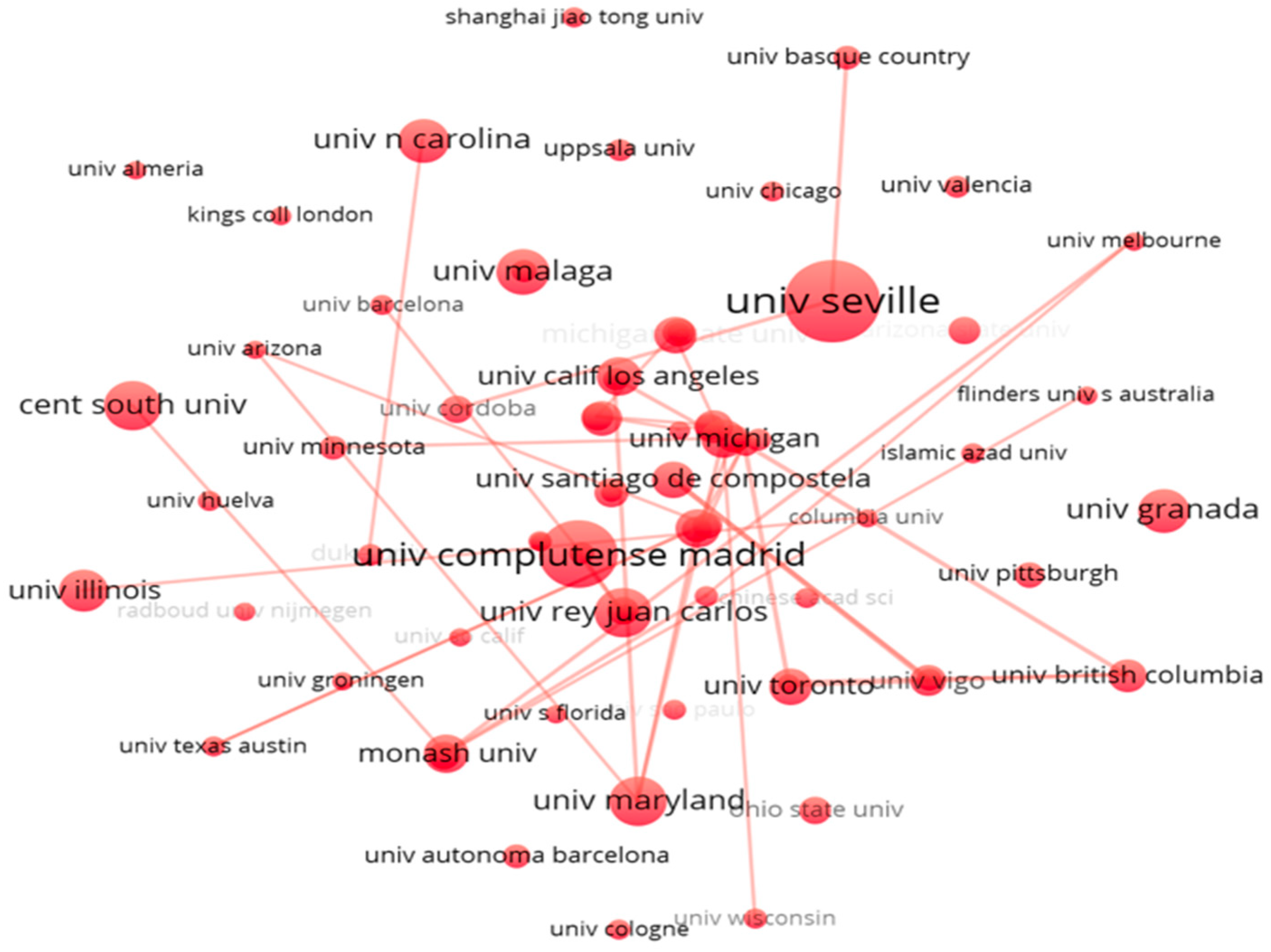
| Organization | n Documents | n Citations | Link Strength |
|---|---|---|---|
| University of Seville | 51 | 648 | 12 |
| Complutense University of Madrid | 40 | 672 | 6 |
| Cent South University | 28 | 550 | 4 |
| University of Maryland | 28 | 1175 | 17 |
| Rey Juan Carlos University | 28 | 163 | 6 |
| University of Malaga | 26 | 330 | 5 |
| University of Granada | 25 | 190 | 3 |
| University of North Carolina | 25 | 619 | 12 |
| University of Illinois | 24 | 860 | 11 |
| University of Michigan | 22 | 751 | 23 |
| Monash University | 21 | 190 | 11 |
| University of California Los Angeles | 21 | 1320 | 5 |
| University of California Santa Bárbara | 21 | 402 | 12 |
| Michigan State University | 20 | 743 | 10 |
| University of Santiago de Compostela | 20 | 364 | 11 |
4.2. Category 2: Actors and Networks of Scientific Production
4.2.1. Scientific Production 1995–2023 and Its Growth
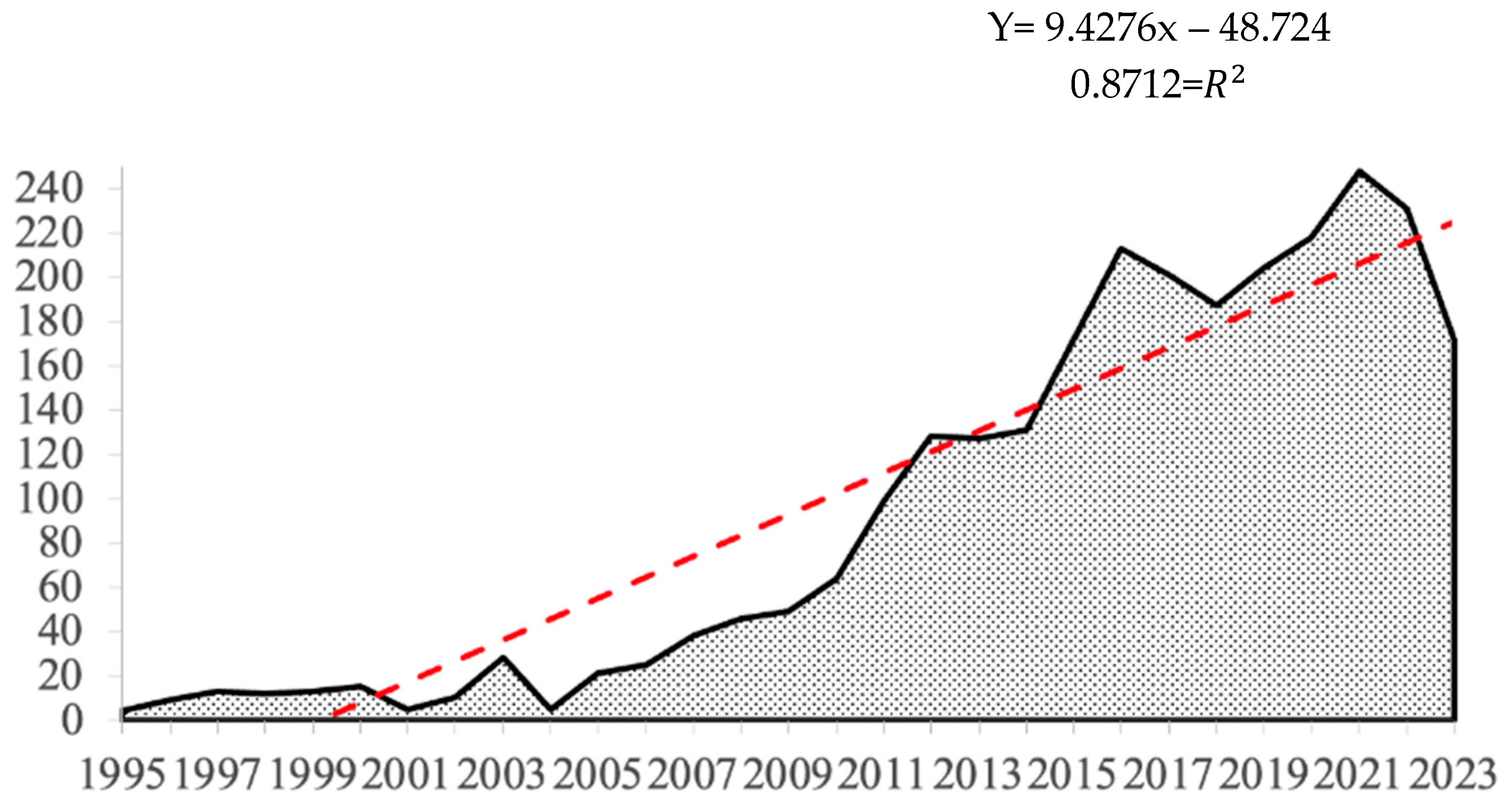
4.2.2. Production, Connections, and Citations of Documents by Country
| Id | Country | n Documents | n Citations | Link Strength |
|---|---|---|---|---|
| 1 | United States | 757 | 24,268 | 225 |
| 2 | Spain | 511 | 4674 | 115 |
| 3 | China | 244 | 4446 | 118 |
| 4 | United Kingdom | 158 | 5610 | 117 |
| 5 | Australia | 119 | 2896 | 61 |
| 6 | Canada | 113 | 2715 | 94 |
| 7 | Brazil | 93 | 398 | 27 |
| 8 | Germany | 90 | 1455 | 53 |
| 9 | The Netherlands | 69 | 1541 | 51 |
| 10 | Italy | 61 | 1015 | 42 |
| 11 | Mexico | 59 | 299 | 29 |
| 12 | Colombia | 52 | 185 | 19 |
| 13 | France | 48 | 810 | 38 |
| 14 | Russia | 44 | 118 | 8 |
| 15 | Sweden | 44 | 626 | 38 |
4.2.3. Notable Authors in Scientific Production
| Id | Author | n Documents | n Citations | Connections |
|---|---|---|---|---|
| 1 | Wu, Jia | 26 | 523 | 35 |
| 2 | Giles, Howard | 16 | 244 | 19 |
| 3 | Kuehnl, Christina | 11 | 0 | 0 |
| 4 | Bernhold, Quinten S. | 9 | 35 | 3 |
| 5 | Chen, Zhigang | 9 | 262 | 22 |
| 6 | Gasiorek, Jessica | 9 | 145 | 10 |
| 7 | Daly, Alan J. | 8 | 168 | 11 |
| 8 | Rocha Marcenaro, Juan Pablo | 8 | 0 | 0 |
| 9 | Cabero-Almenara, Julio | 7 | 170 | 5 |
| 10 | Holmstrom, Inger K. | 7 | 95 | 13 |
| 11 | Sundler, Annelie J. | 7 | 76 | 13 |
| 12 | Himelboim, Itai | 6 | 307 | 0 |
| 13 | Liu, Kanghuai | 6 | 159 | 17 |
| 14 | Zhang, Yan | 6 | 226 | 0 |
| 15 | Älvarez de Sotomayor, Isabel Dans | 5 | 13 | 7 |
4.2.4. Co-Authorship Network in Scientific Production and Connections
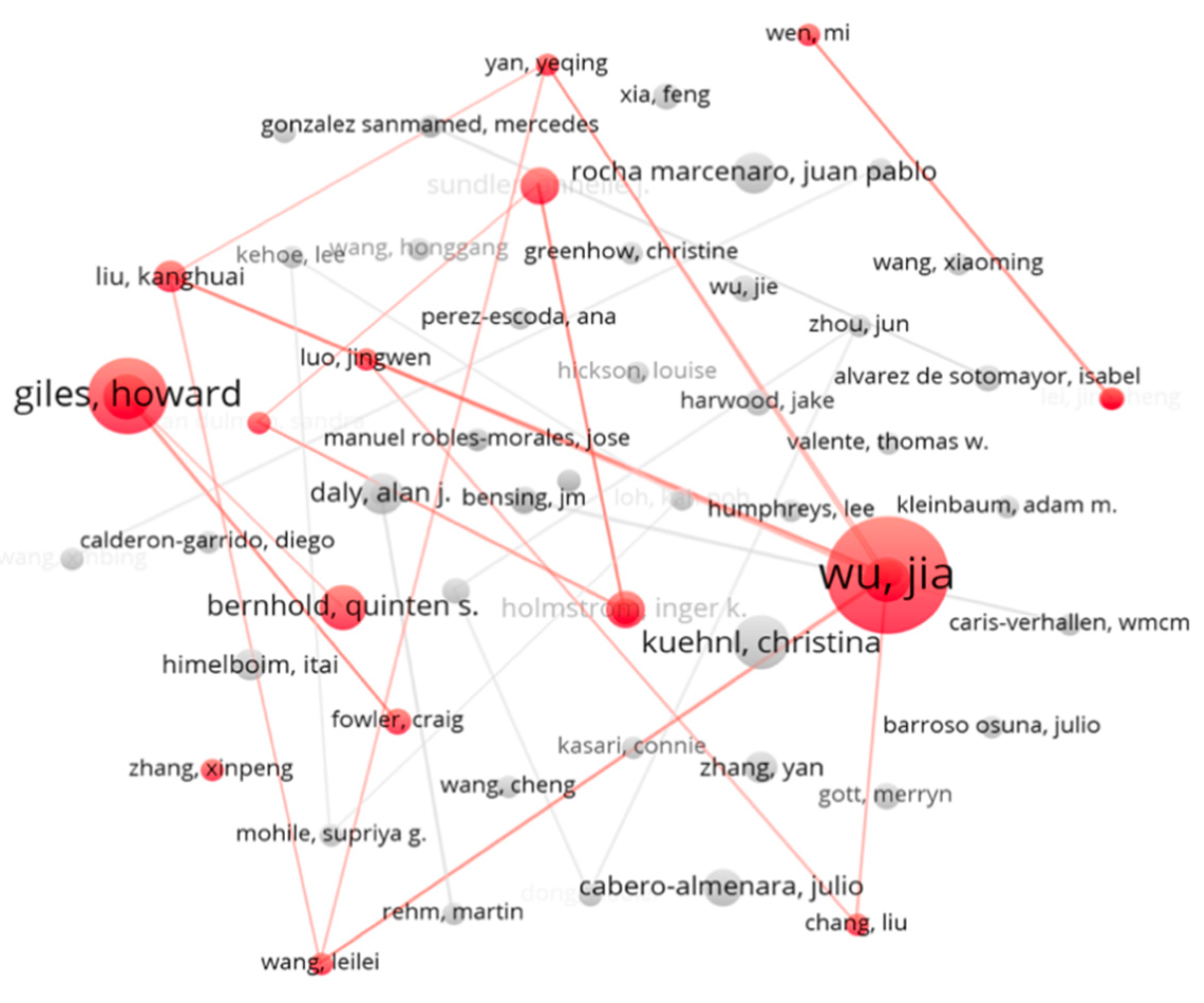
4.2.5. Most Commonly Used Keywords

4.3. Category 3: Training Strategies and Opportunities
4.3.1. Sources with the Highest Production of Scientific Documents
| Source | n Documents | n Citations | Total Link Strength |
|---|---|---|---|
| Profesional de la información | 34 | 343 | 14 |
| International Journal of Environmental | 31 | 295 | 13 |
| Revista Icono 14 | 29 | 251 | 18 |
| Revista Latina de Comunicación Social | 29 | 251 | 29 |
| Plos One | 25 | 878 | 2 |
| Health Communication | 23 | 651 | 17 |
| Vivat Academia | 20 | 33 | 7 |
| Comunicar | 18 | 992 | 75 |
| Cuadernos info | 18 | 182 | 7 |
| Journal of Health Communication | 17 | 518 | 3 |
| Patient education and Counseling | 17 | 430 | 10 |
| Question | 17 | 5 | 4 |
| Journal of Communication | 17 | 46 | 4 |
| Information Technologies and learning tools | 16 | 32 | 0 |
| IEEE Access | 15 | 214 | 3 |
4.3.2. Most Cited Articles
4.3.3. Networks of Scientific Evolution from a Historical Perspective
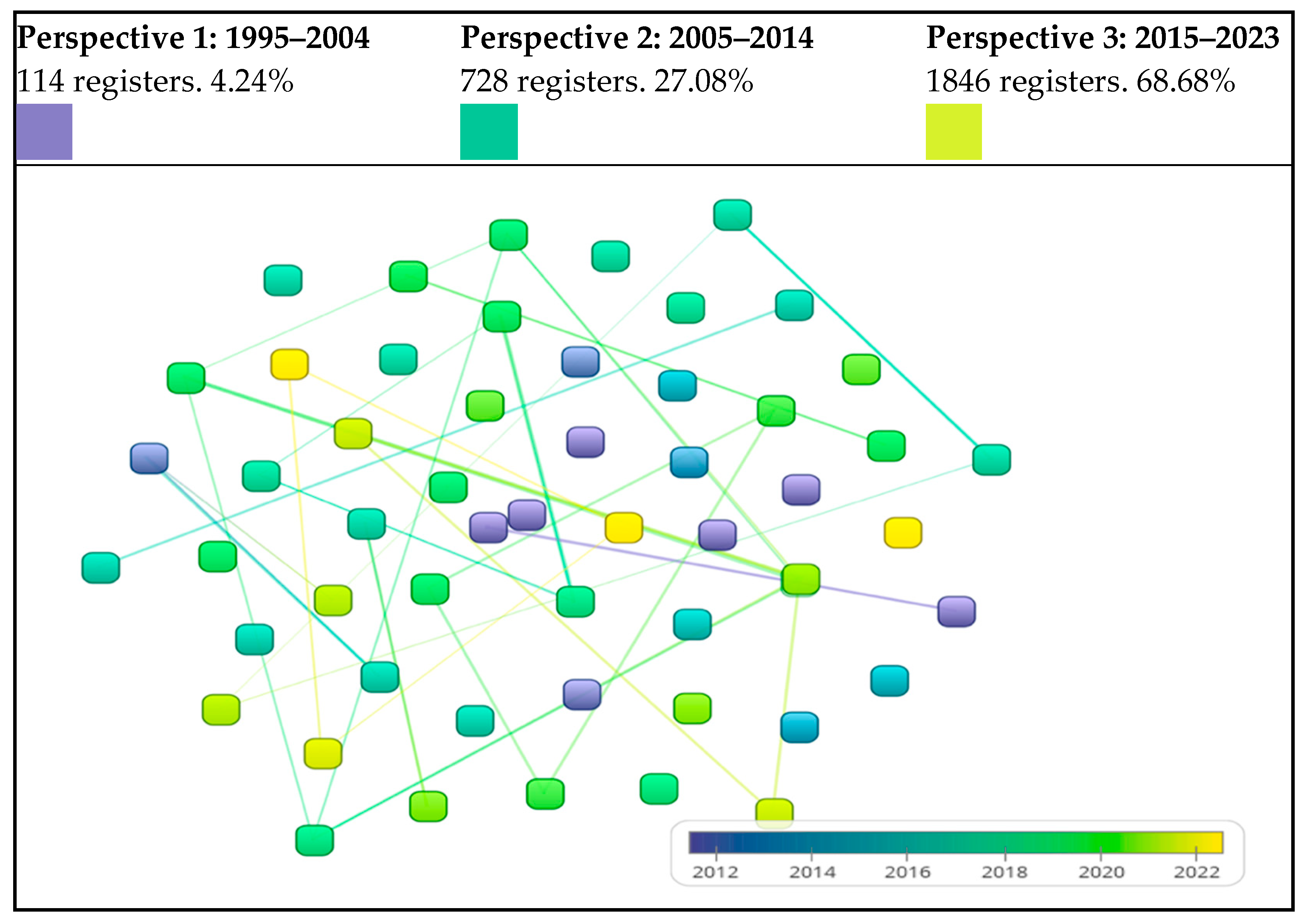
- -
- Perspective 1: Communication and aging. This perspective reflects communication in old age, social skills, behavior, the interdisciplinary approach, and communication education.
- -
- Perspective 2: Social media, public health, and technology. This perspective includes the influence of social media on public health and its promotion, healthcare, attitudes and perceptions of health, intergenerational communication, and aging in relation to social media.
- -
- Perspective 3: Social media, education, and diverse contexts. This perspective includes public health and sexual health, telemedicine, healthcare, teacher, and research training, government and health crisis communication, gender and aggression, journalism, and research.
5. Discussion
6. Conclusions
- -
- Digital divide: Inequality in access, a lack of knowledge regarding the use of social networks, and communicative adaptation in social media.
- -
- Access challenges: Although social media are positive spaces, difficulties can arise when accessing virtual environments, as well as technological limitations or a lack of familiarity with their use.
- -
- Disinformation and misleading advertising: Exposure to potential online risks requires the development of specific skills for safe browsing.
- -
- Health and well-being: Concerns regarding health, successful aging, well-being, and loneliness are necessary areas to work on for sensitively promoting an environment that fosters well-being.
- -
- Social isolation: Maximizing the potential of social media to foster social connections.
Author Contributions
Funding
Institutional Review Board Statement
Informed Consent Statement
Data Availability Statement
Acknowledgments
Conflicts of Interest
References
- Alcolea-Díaz, G., Reig, R., & Mancinas-Chávez, R. (2020). UNESCO’s media and information literacy curriculum for teachers from the perspective of structural considerations of information. Comunicar, 28(62), 99–109. [Google Scholar] [CrossRef]
- Alhothali, H. M. (2021). Inclusion of 21st century skills in teacher preparation programs in the light of global expertise. International Journal of Education and Practice, 9(1), 105–127. [Google Scholar] [CrossRef]
- Balseca, N., Carrillo, F., Merchan, J. M., & Moreno, C. J. (2019). Influencia del marketing, el internet y las redes sociales en adultos mayores: Una revisión de la literatura. Revista Espacios, 40(14), 8. Available online: https://www.revistaespacios.com/a19v40n14/a19v40n14p08.pdf (accessed on 2 December 2024).
- Bernhold, Q. S. (2020). Future time perspective as a moderator of the associations between own age-related communication and aging efficacy. Mass Communication and Society, 24(1), 1–30. [Google Scholar] [CrossRef]
- Bernnhold, Q. S. (2023). Perspectiva del futuro como moderador de las asociaciones entre la comunicación relacionada con la edad y la eficacia del envejecimiento. Southern Communication Journal, 88(2), 131–147. [Google Scholar] [CrossRef]
- Browne, B., Ali, K., Ford, E., & Tabet, N. (2024). Determinants of hospital readmissions in older people with dementia: A narrative review. BMC Geriatrics, 24(1), 336. [Google Scholar] [CrossRef]
- Bunbury Bustillo, E., Pérez Calle, R., & Osuna-Acedo, S. (2022). Las competencias digitales en personas mayores: De amenaza a oportunidad. Vivat Academia, 155, 173–195. [Google Scholar] [CrossRef]
- Cassel, K. D., Hughes, C., Higuchi, P., Lee, P., Fagan, P., Lono, J., Ho, R., Wong, N., Brady, S. K., & Ahuna, W. (2020). No Ke Ola Pono o Nā Kāne: A culturally grounded approach to promote health improvement in Native Hawaiian men. American Journal of Men’s Health, 14(1), 1557988319893886. [Google Scholar] [CrossRef]
- Castleton, A. (2022). Older adults, tablets, and ambivalence: A grounded theory study of a one-tablet-per-older-person, public program in Uruguay. Journal of Aging & Social Policy, 36(2), 325–346. [Google Scholar] [CrossRef]
- Castleton, A., Cid, A., & Silva, D. (2020). “For older folks like me, these things are over us …”: The challenge of embedding tablet computers in everyday life within a geriatric hospital in Uruguay. Educational Gerontology, 46(4), 167–181. [Google Scholar] [CrossRef]
- Chien, S. Y., Zaslavsky, O., & Berridge, C. (2024). Technology usability for people living with dementia: Concept analysis. JMIR Aging, 7, e51987. [Google Scholar] [CrossRef]
- Constantini, J., Bliem, H. R., Crepaz, M., & Marksteiner, J. (2023). Una búsqueda cualitativa de literatura y un estudio piloto de grupos de apoyo en línea para pacientes con demencia y sus cuidadores. Gerontología y Medicina Geriátrica, 9, 23337214231205689. [Google Scholar] [CrossRef] [PubMed]
- Conway, A., Ryan, A., Harkin, D., & Mc Cauley, C. (2023). It’s another feather in my hat: Explorando los factores que influyen en la adopción de aplicaciones con personas que viven con demencia. Dementia, 22(7), 1487–1513. [Google Scholar] [CrossRef]
- Cornwell, B., Laumann, E. O., & Schumm, L. P. (2008). The social connectedness of older adults: A national profile. American Sociological Review, 73(2), 185–203. [Google Scholar] [CrossRef] [PubMed]
- Cotter, K. (2019). Playing the visibility game: How digital influencers and algorithms negotiate influence on Instagram. New Media & Society, 21(4), 895–913. [Google Scholar] [CrossRef]
- Coyne, R. (2016). Mood and mobility: Navigating the emotional spaces of digital social networks. The MIT Press. [Google Scholar] [CrossRef]
- Egger, M., Smith, G. D., & Altman, D. (Eds.). (2001). Systematic reviews in health care: Meta-analysis in context (2nd ed.). BMJ Books. [Google Scholar]
- Egghe, L., & Rousseau, R. (1990). Introduction to informetrics: Quantitative methods in library, documentation and information science. Elsevier Science Publishers. [Google Scholar]
- Escaño, C. (2023). Educación postdigital: Un enfoque desde la pedagogía crítica y mediática para un contexto post-COVID19. Revista Mediterránea de Comunicación, 14(2), 243–257. [Google Scholar] [CrossRef]
- Fernández, M. (2012). Redes sociales y mujeres mayores: Estudio sobre la influencia del uso de las redes sociales en la calidad de vida. In Trabajo de posgrado. Universidad de Oviedo. [Google Scholar]
- Fiel, J. (2006). Lifelong learning and the new educational order. Trentham Books. [Google Scholar]
- Figueiredo, T., Midão, L., Carrilho, J., Videira Henriques, D., Alves, S., Duarte, N., Bessa, M. J., Fidalgo, J. M., García, M., Facal, D., Felpete, A., Filgueira, I. R., Carlos Bernárdez, J., Rodríguez, M., & Costa, E. A. (2024). A comprehensive analysis of digital health-focused living labs: Innovative approaches to dementia. Frontiers in Medicine, 11, 1418612. [Google Scholar] [CrossRef]
- Freire, P. (1970). Pedagogía del oprimido. Siglo XXI Editores. [Google Scholar]
- Garfield, E. (1979). Citation indexing: Its theory and application in science, technology, and humanities. ISI Press. [Google Scholar]
- Gasiorek, J., Fowler, C., & Giles, H. (2019). Communication and successful aging: Testing alternative conceptualizations of uncertainty. Communication Monographs, 86(2), 229–250. [Google Scholar] [CrossRef]
- Giles, H., Edwars, A. L., & Walther, J. B. (2023). Communication accommodation theory: Past accomplishments, current trends, and future prospects. Language Sciences, 99, 101571. [Google Scholar] [CrossRef]
- Gil-Quintana, J. (2023). Educación y comunicación en una sociedad postdigital: Investigación documental y análisis de perspectivas. Editorial Octaedro. [Google Scholar]
- Gil-Quintana, J., García Blazquez, E., Hueso-Romero, J. J., & Rodriguez Romero, L. M. (2024). Redes comunicativas universitarias sNOOC por la educación mediática de la tercera edad. Texto Livre, Belo Horizonte-MG, 18, e53823. [Google Scholar] [CrossRef]
- Gough, D., Oliver, S., & Thomas, J. (2012). An introduction to systematic reviews. SAGE Publications. [Google Scholar]
- Haidt, J. (2001). The emotional dog and its rational tail: A social intuitionist approach to moral judgment. Psychological Review, 108(4), 814–834. Available online: https://bit.ly/3KYeL4r (accessed on 19 December 2024). [CrossRef]
- Higgins, J. P. T., & Green, S. (Eds.). (2008). Cochrane handbook for systematic reviews of interventions. Wiley-Blackwell. [Google Scholar]
- Himelboim, I., Janice Lee, J., Cacciatore, M. A., Kim, S., Krause, D., Miller-Bains, K., Mattson, K., & Reynolds, J. (2023). Vaccine support and hesitancy on Twitter: Opposing views, similar strategies, and the mixed impact of conspiracy theories. In T. Ginossar, S. F. A. Shah, & D. Weiss (Eds.), En: Vaccine Communication Online. Palgrave Macmillan. [Google Scholar]
- Himelboim, I., Xiao, X., Lai Lee, D. K., Wang, M. Y., & Borah, P. (2020). A Social Networks Approach to Understanding Vaccine Conversations on Twitter: Network Clusters, Sentiment, and Certainty in HPV Social Networks. Health Communication, 35(5), 607–615. [Google Scholar] [CrossRef]
- Hird, N., Osaki, T., Ghosh, S., Palaniappan, S. K., & Maeda, K. (2024). Habilitar la personalización para la estimulación cognitiva digital para apoyar la comunicación con personas con demencia: Estudio de intervención piloto como preludio al desarrollo de la IA. Investigación Formativa JMIR, 8, e51732. [Google Scholar] [CrossRef]
- Illeris, K. (2004). The three dimensions of learning: Contemporary learning theory in the tension field between the cognitive, the emotional and the social. Krieger Publishing. [Google Scholar]
- Iniesta-Alemán, I., Berlanga Fernández, I., & Bandrés-Goldára, E. (2024). La eficacia publicitaria del marketing de influencers en el sector de la moda. Revista ICONO 14. Revista científica de Comunicación y Tecnologías Emergentes, 22(1), e2064. [Google Scholar] [CrossRef]
- Jarvis, P. (2004). Adult education and lifelong learning: Theory and practice. Routledge. [Google Scholar]
- Jiang, M., Rifon, N. J., Cotten, S. R. M., Alhabash, S., Tsai, H. Y. S., Shillair, R., & Larose, R. (2022). Bringing older consumers onboard to online banking: A generational cohort comparison. Educational Gerontology, 48(3), 114–131. [Google Scholar] [CrossRef]
- Kaufman, C. (2021). Civic education in a fake news era: Lessons for the methods classroom. Journal of Political Science Education, 17(2), 326–331. [Google Scholar] [CrossRef]
- Levy, B. R. (2009). Stereotype embodiment: A psychosocial approach to aging. Current Directions in Psychological Science, 18(6), 332–336. [Google Scholar] [CrossRef]
- Levy, S. R., & Macdonald, J. L. (2016). Progress on understanding ageism. Journal of Social Issues, 72(1), 5–25. [Google Scholar] [CrossRef]
- Lorente, R. (2017). La soledad en la vejez: Análisis y evaluación de un programa de intervención en personas mayores que viven solas [Doctoral thesis, Universidad Miguel Hernández]. [Google Scholar]
- López-González, H., Sosa, L., Sánchez, L., & Faure-Carvallo, A. (2023). Educación mediática e informacional y pensamiento crítico: Una revisión sistemática. Revista Latina de Comunicación Social, 81, 399–423. [Google Scholar] [CrossRef]
- Miguel Cruz, A., Daum, C., Comeau, A. M., Salamanca, J. D. G., Mclennan, L., Neubauer, N., & Liu, L. (2023). Acceptance, adoption, and usability of information and communication technologies for people living with dementia and their care partners: A systematic review. Disability and Rehabilitation: Assistive Technology, 18(4), 443–457. [Google Scholar] [CrossRef]
- Moed, H. F. (2005). Citation analysis in research evaluation. Springer. [Google Scholar]
- Moher, D., Liberati, A., Tetzlaff, J., Altman, D. G., & The PRISMA Group. (2009). Preferred reporting items for systematic reviews and meta-analyses: The PRISMA statement. PLoS Medicine, 6(7), e1000097. [Google Scholar] [CrossRef] [PubMed]
- Morillas, A. S., & Navarro, G. M. (2013). La influencia de las nuevas tecnologías: Videojuegos, redes sociales e internet, en los consumidores seniors en España. En Actas del I Congreso Internacional Comunicación y Sociedad. Available online: https://dialnet.unirioja.es/servlet/articulo?codigo=4249417 (accessed on 20 June 2025).
- Nef, T., Ganea, R. L., Müri, R. M., & Mosimann, U. P. (2013). Social networking sites and older users—A systematic review. International Psychogeriatrics, 25(7), 1041–1053. [Google Scholar] [CrossRef] [PubMed]
- Ng, R., & Levy, S. R. (2018). The influence of age-based stereotypes on older adults’ memory performance: A meta-analysis. Psychology and Aging, 33(5), 743–756. [Google Scholar] [CrossRef]
- Nygård, T., Hirvonen, N., Räisänen, S., & Korkeamäki, R. L. (2021). Ask your mother! Teachers’ informational authority roles in information-seeking and evaluation tasks in health education lessons. Scandinavian Journal of Educational Research, 65(6), 972–985. [Google Scholar] [CrossRef]
- Pardal-Refoyo, J. L., & Pardal-Peláez, B. (2020). Anotaciones para estructurar una revisión sistemática. Revista ORL, 11(2), 155–160. [Google Scholar] [CrossRef]
- Richardson, M., Zorn, T. E., & Weaver, K. (2011). Older people and new communication technologies narratives from the literature. Annals of the International Communication Association, 35(1), 121–152. [Google Scholar] [CrossRef]
- Sabot, K., Blanchhet, K., Berhanu, D., Spicer, N., & Schellenberg, J. (2020). Professional advice for primary healthcare workers in Ethiopia: A social network analysis. BMC Health Services Research, 20(1), 551. [Google Scholar] [CrossRef]
- Sales, A. E., Estabrooks, C. A., & Valente, T. W. (2010). The impact of social networks on knowledge transfer in long-term care facilities: Protocol for a study. Implementation Science, 5(1), 1–10. [Google Scholar] [CrossRef]
- Solla Price, D. (1963). Little science, big science. Columbia University Press. [Google Scholar]
- Tejedor, S., Romero-Rodríguez, L. M., & Gracia-Villar, M. (2024). Desvelando la verdad: Una revisión sistemática de la investigación sobre verificación de datos y noticias falsas en ciencias sociales. Revista Electrónica de Tecnologías de la Comunicación y los Medios, 14(2), e202427. [Google Scholar] [CrossRef]
- Thompson, C., Gordon, A., Khaliq, K., Daffu-O’Reilly, A., Willis, T., Noakes, C., & Spilsbury, K. (2024). Quality in care homes: How wearable devices and social network analysis might help. PLoS ONE, 19(5), e0302478. [Google Scholar] [CrossRef]
- Torres Salinas, D., Robinson García, N., & Jiménez Contreras, E. (2023). La ruta bibliométrica hacia el cambio tecnológico y social: Revisión de problemas y desafíos actuales. Available online: https://digibug.ugr.es/handle/10481/81091 (accessed on 1 December 2024).
- Toso, F., Brankaert, R., Hendriks, N., Lenaerts, L., & Wilkinson, A. (2023). Reflexionando sobre Living Labs como redes de colaboración de múltiples partes interesadas para evaluar productos tecnológicos para personas que viven con demencia. Revista internacional de investigación ambiental y salud pública, 20(3), 1673. [Google Scholar] [CrossRef]
- UNESCO. (1972). Aprender a ser: La educación del futuro. Herder. [Google Scholar]
- UNESCO. (2018). Media and information literacy. Available online: https://bit.ly/2TKTTzP (accessed on 21 December 2024).
- Verloo, H., Lorette, A., Rosselet Amoussou, J., Gillès de Pélichy, E., Matos Queirós, A., von Gunten, A., & Perruchoud, E. (2021). Uso de Living Labs para explorar las necesidades y soluciones para adultos mayores con demencia: Revisión del alcance. Envejecimiento JMIR, 4(3), e29031. [Google Scholar] [CrossRef]
- Waltman, L., & van Eck, N. J. (2012). A new methodology for constructing a publication-level classification system of science. Journal of the American Society for Information Science and Technology, 63(12), 2378–2392. [Google Scholar] [CrossRef]
- Weiding, J., & Kuehnl, C. (2023). Improving the effectiveness of personalized recommendations through attributional cues. Psychology & Marketing, 40(12), 2559–2575. [Google Scholar] [CrossRef]
- Yeaxlee, B. (1929). Lifelong education. Cassel and Company. [Google Scholar]
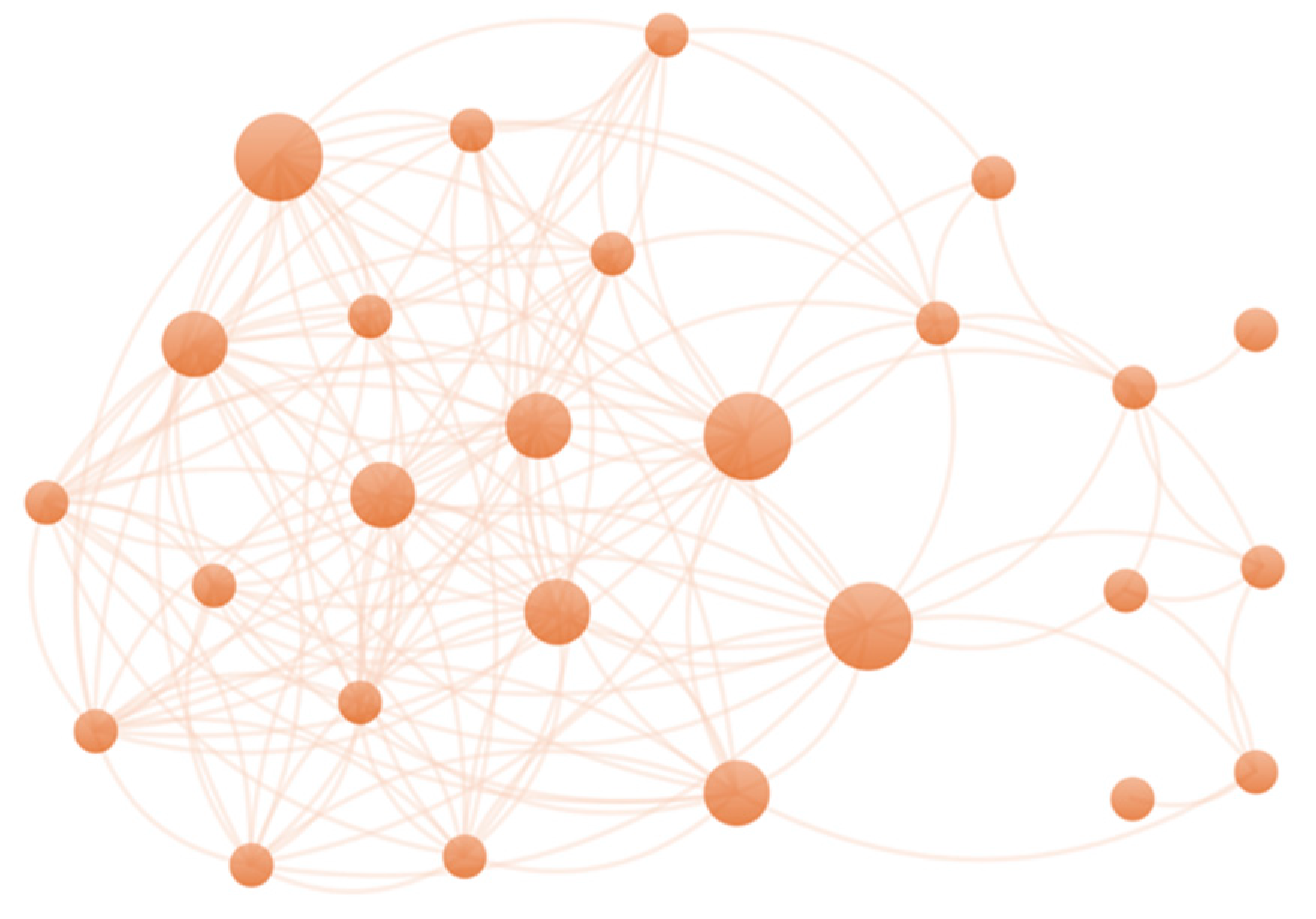
| Search Algorithm * | Database | n Registries |
|---|---|---|
| “Redes sociales” or “Social Networks” (Title) or “Comprensión crítica” or “Critical understanding” (Title) or “Comunicación” or “Communication” (Title) and “Personas mayores” or “vejez” or “Envejecimiento” or “Tercera edad” or “Gente mayor” or “ancients” or “Jubilados” or “Jubiladas” or “Gente mayor” or “Ancianía” or “Older people” or “Old age” or “Aging” or “Third age” or “Elderly” or “Retired” or “Older people” (Topic) | Web of Science (All database|All Collections) | 2605 |
| Date range: 1995–2023 | ||
| Type of documents: AND dt = (“article” or “book chapter” OR “book”) | ||
| Id | Research Areas | N Documents | % |
|---|---|---|---|
| 1 | Behavioral Sciences | 775 | 28.8 |
| 2 | Psychology | 754 | 28.0 |
| 3 | Health Care Sciences Services | 649 | 24.1 |
| 4 | Computer Science | 612 | 22.7 |
| 5 | Geriatrics Gerontology | 475 | 17.6 |
| 6 | Sociology | 402 | 14.9 |
| 7 | Public Environmental Occupational Health | 268 | 9.9 |
| 8 | Mathematics | 233 | 8.6 |
Disclaimer/Publisher’s Note: The statements, opinions and data contained in all publications are solely those of the individual author(s) and contributor(s) and not of MDPI and/or the editor(s). MDPI and/or the editor(s) disclaim responsibility for any injury to people or property resulting from any ideas, methods, instructions or products referred to in the content. |
© 2025 by the authors. Licensee MDPI, Basel, Switzerland. This article is an open access article distributed under the terms and conditions of the Creative Commons Attribution (CC BY) license (https://creativecommons.org/licenses/by/4.0/).
Share and Cite
Gil Quintana, J.; Hueso Romero, J.J.; Romero Rodríguez, L.M. Social Media and Older Adults (1995–2023): A Bibliometric Analysis with Implications for Media Education in Lifelong Learning. Educ. Sci. 2025, 15, 811. https://doi.org/10.3390/educsci15070811
Gil Quintana J, Hueso Romero JJ, Romero Rodríguez LM. Social Media and Older Adults (1995–2023): A Bibliometric Analysis with Implications for Media Education in Lifelong Learning. Education Sciences. 2025; 15(7):811. https://doi.org/10.3390/educsci15070811
Chicago/Turabian StyleGil Quintana, Javier, José Javier Hueso Romero, and Luis Miguel Romero Rodríguez. 2025. "Social Media and Older Adults (1995–2023): A Bibliometric Analysis with Implications for Media Education in Lifelong Learning" Education Sciences 15, no. 7: 811. https://doi.org/10.3390/educsci15070811
APA StyleGil Quintana, J., Hueso Romero, J. J., & Romero Rodríguez, L. M. (2025). Social Media and Older Adults (1995–2023): A Bibliometric Analysis with Implications for Media Education in Lifelong Learning. Education Sciences, 15(7), 811. https://doi.org/10.3390/educsci15070811







